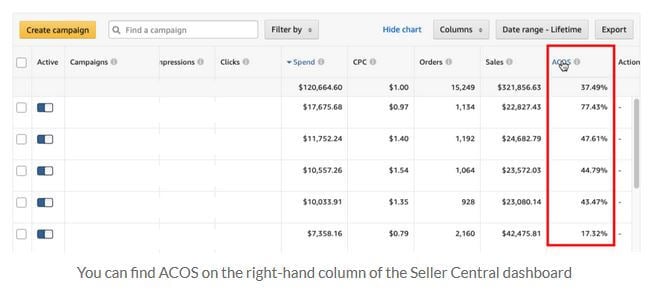Table of Contents
 If you are selling on Amazon, you are most likely dealing with dozens of effectiveness indicators, including but not limited to your conversion rate, customer satisfaction, loyalty rates, churn rates, net promoter score, and other important metrics. In addition, the advertising cost for sale and the total advertising cost of sale are other essential figures to keep an eye on. They can help you make sure you are on the right track with your advertising campaigns.
If you are selling on Amazon, you are most likely dealing with dozens of effectiveness indicators, including but not limited to your conversion rate, customer satisfaction, loyalty rates, churn rates, net promoter score, and other important metrics. In addition, the advertising cost for sale and the total advertising cost of sale are other essential figures to keep an eye on. They can help you make sure you are on the right track with your advertising campaigns.
Let’s find out how to calculate them and what ACoS and TACoS on Amazon mean.
Amazon ACoS and TACoS – What Are They?
Amazon TACoS stands for Total Advertising Cost of Sale. It is a metric that helps advertisers understand the overall impact of their advertising efforts on their total sales. Unlike ACoS (Advertising Cost of Sale), which measures the efficiency of your ad spend relative to the revenue generated from those ads, TACoS provides a broader perspective by taking into account your total sales, both organic and ad-driven.
TACoS is calculated by dividing your total advertising spend by your total sales, then multiplying by 100 to get a percentage. This percentage gives you a clearer picture of how much you’re spending on advertising in relation to the total revenue your business is generating.
Suppose you are selling dog collars at $5 per item. You decide to advertise an item and pay $10 for Amazon PPC ads, getting ten sales as a return. Here is how to find out your ad revenue.
10$ (your spending for PPC ads) /50$ (your revenue from selling this item to five buyers) *100% = 5%.
While knowing how to calculate the correlation between your ad spend and revenue is better, you can still find your ACoS right from the Seller Central dashboard.
Amazon TACoS, which stands for total ACos Amazon or Total Advertising Cost of Sale Amazon, gives us a more holistic picture since it considers all your sales within an ad campaign. To calculate TACoS, you must divide your total advertising spend by the total revenue generated and multiply it by 100%.

Amazon TACoS, which stands for total ACos Amazon or Total Advertising Cost of Sale Amazon, gives us a more holistic picture since it considers all your sales within an ad campaign. To calculate TACoS, you have to divide your total advertising spend by total revenue generated and multiply it by 100%.
TACoS vs. ACoS: Difference
The Purpose of ACoS
ACoS is a specific metric that focuses solely on the relationship between ad spend and the revenue generated from those ads. It is calculated by dividing your advertising spend by the revenue generated from your ads, then multiplying by 100 to get a percentage. A lower ACoS indicates a more efficient ad campaign, as it means you’re spending less on advertising to generate a higher revenue from those ads.
The Broader Scope of TACoS
While ACoS is crucial for understanding the efficiency of individual ad campaigns, TACoS offers a more comprehensive view of your overall advertising strategy. By considering total sales, TACoS allows you to see how your ad spend impacts not just direct sales from ads but also organic sales that may be influenced by increased brand awareness and visibility.
Why Both Metrics Matter
Both ACoS and TACoS provide valuable insights, but they serve different purposes. ACoS helps you optimize individual ad campaigns for short-term efficiency, while TACoS enables you to assess the long-term effectiveness of your advertising efforts and make strategic decisions that drive sustainable growth.
How to Interpret TACoS and ACoS?
What is a good TACoS on Amazon? Ideally, both indicators should be as low as possible, meaning that you are generating strong and steady sales at a low total advertising cost. As one more option, these indicators should remain flat, driving sales at a stable pace. But suppose your sales are not increasing and there is a high TACoS. In that case, it means something is wrong with your ad – you are targeting the wrong user group, or there are advertising setup gaps. Still, if you launch a new product, the situation when TACoS increases can be pretty normal. So in building brand awareness, investing in advertising more than getting in return is okay.
How Can Sellers Improve Their TACoS on Amazon?
To achieve a decreasing Amazon TACoS, one of the following situations needs to happen:
- Situation 1: ad spending decreases while total sales stay the same or increase (e.g., by using negative keywords to cut wasted ad spend);
- Situation 2: ad spending stays the same while total sales increase (e.g., by moving the budget to more efficient targets);
- Situation 3: ad spending increases, but total sales increase at a faster rate (e.g., by increasing ad spending for an optimized and high-converting product listing).
Below, we’ll outline how you can drive your TACoS lower by improving ad efficiency and boosting organic sales.
Improve ad efficiency
One of the most effective ways to cut wasted ad spending (situation 1 above) and boost your ad sales (situations 2 and 3) is to optimize your Amazon ads.
To do so, you can focus on improving the following metrics:
- click-through rate: drive more traffic to your product detail page;
- cost per click (CPC): make sure your bids are competitive while not overpaying for ads;
- conversion rate: attaining a higher conversion rate means more profitable ads;
- average sales price: assuming all else equal, a higher average sales price equates to higher profitability.
Boost your organic sales
Apart from using Amazon advertising in an effective way, the best way to bring in strong organic sales is with an optimized product listing.
This means you need to:
- make sure the listing’s search terms are relevant and up to date;
- optimize your product content: images, titles, bullet points, description, A+ Content, and videos;
- manage your product reviews and questions.
Why Does TACoS Matter to Advertisers?
Both ACoS and TACoS are important since they are core metrics reflecting the effect of your advertising spending and effort. Monitoring these indicators should be an ongoing process. Ideally, your sales velocity should grow while TACoS decreases because of brand awareness. After the users become aware of your brand and your product, you can spend less on advertising and more on relationship-building and customer service.
Holistic View of Advertising Impact
TACoS is essential because it offers a holistic view of how your advertising efforts impact your entire business. By considering total sales, TACoS helps you understand the broader influence of your ads on brand awareness, customer acquisition, and overall revenue. This comprehensive perspective is crucial for making informed decisions that align with your long-term business goals.
Optimizing Long-Term Growth
While ACoS focuses on short-term campaign efficiency, TACoS allows you to optimize for long-term growth. By analyzing your TACoS, you can identify trends and patterns in your advertising performance, enabling you to adjust your strategies for sustained success. This long-term focus is vital for building a strong brand and achieving lasting profitability.
Making Strategic Decisions
TACoS provides the data you need to make strategic decisions about your advertising budget and resource allocation. By understanding how your ad spend impacts total sales, you can identify which campaigns are driving the most value and allocate your budget accordingly. This strategic approach ensures that you’re investing in the right areas to maximize your return on investment (ROI).
As for the latter task, pay attention to the feedback shared by your users to identify the customer service gaps and improve them. For example, you can do it with the help of SageMailer. It is an Amazon feedback management tool that instantly notifies you of a new positive, negative or critical review so that you can respond to it asap and take the necessary measures.
Give SageMailer a try and find out how to effectively manage your customer feedback. Register now to access SageMailer for free for 30 days!

